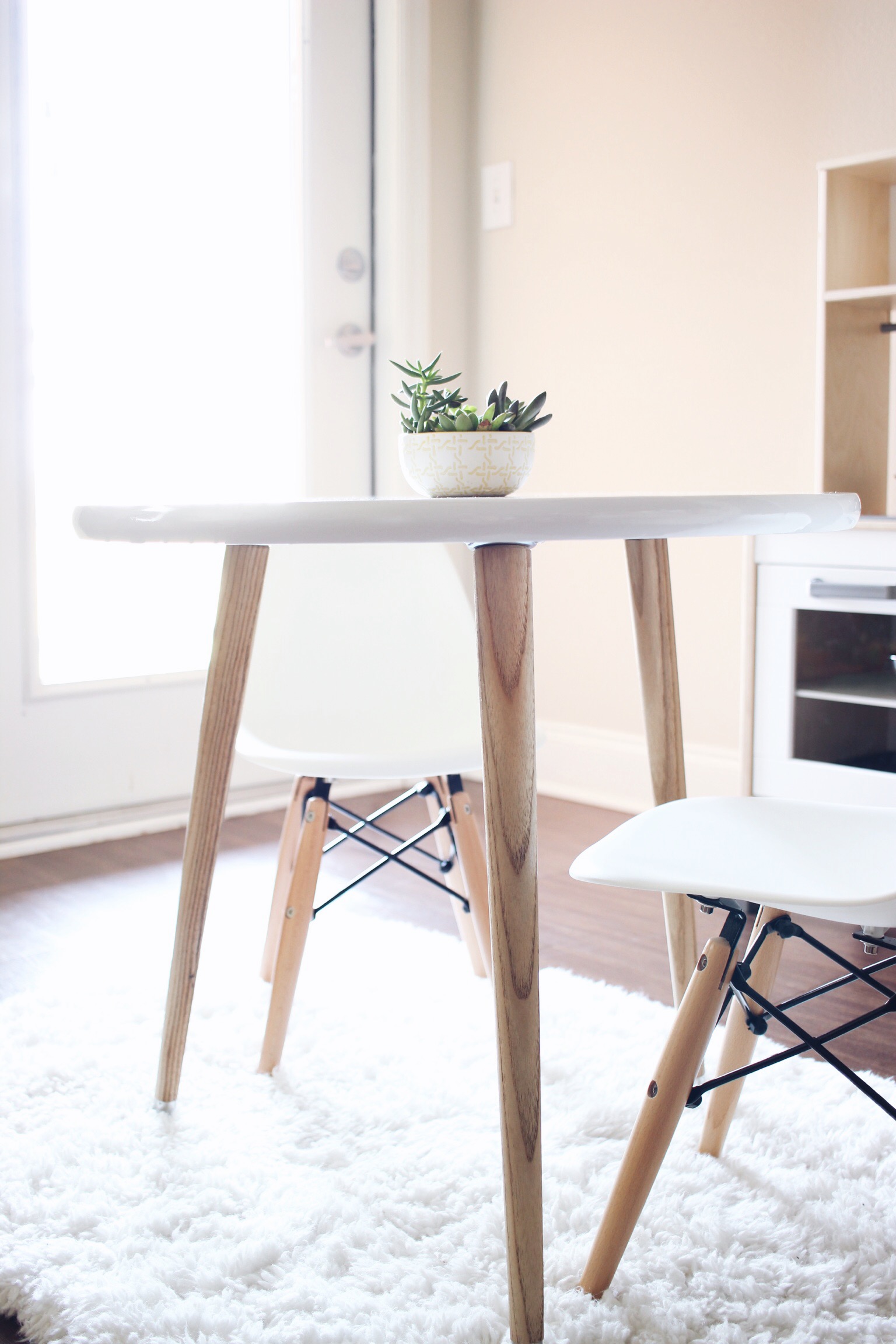DIY Furniture | Kids Scandinavian Tripod Table
Please tell me why I would decide to make a table instead of going the simple route and just buy one like normal people do. I'm adding that question to the list of others that seem to escape me because this is one of those projects where I had to stop (on several occasions) to scratch my head and ask myself, what have I gotten myself into!? At the end of the day, it was totally worth it, but let's be honest, getting there was far from a walk in the park.
I now probably have a degree in painting from all of the articles that I devoured and the troubleshooting I went through to complete this project. Little did I know that painting a table is not as basic as it sounds. All I know is that I'm happy to share everything I learned and then some so that this project will be a breeze for you. In other words, I'm happy to have been your guinea pig! That's what DIYs are for, right.
In the mayhem that was this project, I decided that by taking photos, I would probably sabotage myself even more, so I opted not to do so. I do, however have the process down in my memory, so hopefully you don't mind that I don't have any photos of the process to share.
For starters, it is very very very - and I mean VERY - important to sand down the wood before you proceed with anything. Call me dumb, but I decided that I could just skip that process. Soooo ... long story short, let's just say that I was kicking myself in the butt for it. Another important step is to use primer, then sand, then primer, then sand, and repeat that process until you have a smooth base for your paint. For me, it took several times to achieve a flat surface because I did run into problems with my wood having cracks in it, which I was supposed to fill in with wood putty, but thought I could skip that step as well.
Since we're on the topic of wood having cracks in it, I also learned (after the fact) that all wood isn't created equal and that certain wood is better for painting and attaining a smooth finish. I did not know this, so I had to deal with the pine that I had already purchased. I don't have anything against pine, but if I had known that there were better options, I probably would have went with those instead so that I didn't have to deal with so many knots and cracks in my wood. Since pine wood has so many knots, you will have to use a primer that will be able to hide them and keep them from peeking through in the future. You may also have to apply wood putty to fill in holes or uneven spots. It was an easy option considering it was pre-cut, but if you want to explore other options, I encourage you to do so.
For the most crucial step - the paint - this is where things got really complicated at first. I decided to use an oil-based paint instead of a water-based paint, in other words, latex paint. An article I read suggested that it was the best choice for tables that receive a lot of use because it stands up to wear very well. What I did not know at the time was that oil-based paint takes longer to dry, can not be washed off of brushes (unless you use turpentine), smells really really bad, can be harmful, and is not eco-friendly! *yikes* So, I learned after the fact that maybe I should've just went with a latex paint, and my life would've probably been way easier and less stressful.
Seeing that I was able to complete this project (finally) after several weeks due in major part to roadblocks and troubleshooting, I am still so pleased with the outcome, and I'm so proud of it. It was so worth every headache because I learned so much from this project. It's actually a really easy project once you know what you're doing. #notetoself
I just wanted to be completely transparent and honest with you guys beforehand about my experience. If you decide to do this project, here's the step by step of what you need to do to achieve the exact same thing. It'll be way easier for you now that I have all of the techniques figured out and outlined. I do recommend you decide on what type of paint will work best for you, though. If you decide to use latex paint, please do some research first as to how to use it since that's not the paint that I will be using for this project. You'll be surprised as to what a difference a little technique or Google search will do for you and the outcome of your project.
supplies
2" Polyester Bristle Paintbrush or foam brushes - I do not recommend the ones that are pictured, which are woven and knit rollers. They had a lot of fiber fall-out and created bubbles. I ended up using the ones listed here and got better results.
Turpentine - To clean your bristle brush in between coats, or you can just use foam brushes and discard after each use making cleanup easier.
Power Drill
Wood putty or filler (optional)
Sanding Respirator
Paint Can Opener
Something to stir paint with
String (to measure with)
Measuring tape
Instructions
I recommend you do this project in an area without a lot of wind, but with good ventilation like a garage.
Sand
The first thing you'll need to do is to sand the pine wood round to get a smooth base. I would recommend using the 120 grit for rougher areas (the edges of the table), then go over it with the 220 grit paper. For the top of the table, I used the 220 as it is a lot smoother. Remove excess dust with a tac cloth.
Prime & FILL
Spray a thin layer of primer in long strokes with the grain of the wood. Let dry for an hour, then sand with 220 or 120 grit sand paper. Remove excess dust with tac cloth, then repeat steps until you feel like you have a smooth finish. I primed and sanded my table 3 times, but it just depends on your individual results. After the first coat of primer, you will notice that the imperfections will start to show, like scratches, dings, and cracks. If they are not that bad, the primer will fill them in, but if they are deep, you will need to fill them in with wood putty or filler. If you do use wood putty or filler, all you would do is apply it according to the package directions, let it dry, sand smooth, wipe with tac cloth, then add another layer of primer and continue with the process that I've mentioned beforehand.
Paint
The key to getting a smooth finish is to have a smooth base to work with, so I can't stress enough about the importance of sanding as well as removing all dust particles and impurities before you paint. Once you have that covered, you are ready to roll - literally! Working with oil-based paint is a little tricky, but the key to applying it is to not apply it too thick because it will take longer to dry and it will run - oh it will RUN - and you don't want to be like me, stuck sanding it all down again. I learned the hard way.
To apply, use long strokes along the grain of the wood and try not to go over the same spot you painted too many times or it will drag. Since oil-based paint takes longer to dry, it will smooth out, so don't worry too much about getting it completely perfect. I recommend applying paint to the top of the table first, then to the sides of the table (remember, thin coats). Allow your paint to dry completely; dry time will vary by climate. This can take anywhere from 24-72 hrs to weeks, so patience is a virtue here.
Before you apply your second coat, look for any areas where dust or particles may have entered and sand those areas down with 220 grit sand paper. Completely wipe your table down with a tac cloth to make sure you have a clean surface. To apply the second coat, apply as you did the first. Two coats should be all that you need, but it really depends on your preference. I had to do 3 coats, but that's because I messed up and had to sand down the drips from the second coat I did.
Allow your table to dry for several weeks because the fumes will be strong for a while. Oil-based paint also takes a while to cure, but you can still use it. In the meantime, just be careful not to bang it or it will dent. Once it is fully dry, the finish will cure and harden.
Legs
For the legs, I do recommend installing them to your table before you apply the polycrylic gloss. To do this, you will need to first measure your table's circumference with string, which will roughly be 75", then cut the string into thirds (25" each). Using the string that you just cut, lay it out along the circumference of the table. At each end, this is where you will mark your spots for where your legs will be installed. Mark your spots at a 4" depth from the edge of the table. Now you can place your top plates on and get to drilling. Make sure that your top plates are angled outward first. It's a simple step that can be overlooked. Mark all four holes on each top plate as a guide, then drill in place. Once that's all done, you can now screw on your legs.
Now it's time to paint your legs with the polycrylic gloss. I didn't sand mine, but I do recommend you do so to get a smoother finish before you paint. Mine turned out just fine, so it's up to you. Since the polycrylic base is water-based, the wood grain will raise a bit, which you'll either want to sand smooth or you can leave be (which I did). I just used one coat to maintain that natural finish. Let the legs dry for an hour and they're good to go!
That's a wrap for this project! The play kitchen from Ikea was a nice surprise that I ran into while on my trip to the Dallas location, so I had to snatch it up. I think it looks amazing alongside the table! I am going for a Scandinavian look for his play area and for our home, so it's coming together very nicely. I did have a moment where I was considering going for a Scandinavian whitewashed finish, which also would've been pretty. I was able to find the plastic Eames chairs at Hobby Lobby - and they were on SALE! Big win for me. My small succulent arrangement is perfect for this small-sized table, and Uriah doesn't even mess with it. Don't be scared to use white. These are all materials that are easy to clean up and maintain. Uriah has already drawn on the chairs, and it was a cinch to remove.
This project was so worth it. I mean, look at this space! I'm in LOVE. Uriah has been enjoying his little setup, and he can finally have his own kitchen to play in. He's all about being in the kitchen with me, so I just had to do this for him.
Do let me know if you try this project out and if you have any questions, I'd love to help. It will be 100% worth every ounce of love and sweat you put into it!
Did you enjoy this DIY? I'd love to hear your thoughts in the comments below!





















